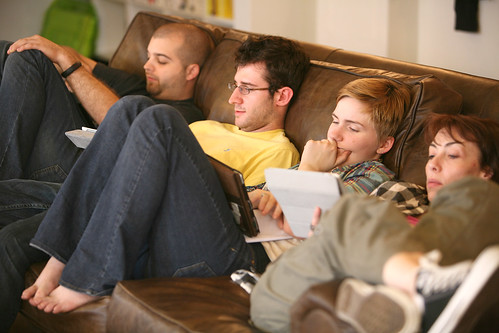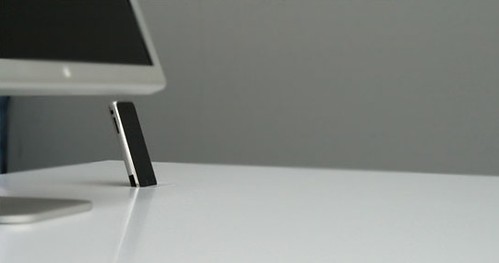Whilst developments in technology have changed the way people create furniture designs over the last century, it has also had a major impact on the actual designs themselves. Today furniture designers have no choice but to integrate new aesthetics that reflect how we use our furniture. For example, where once we would simply sit on a sofa to watch the television, we may now sit on the same sofa whilst we browse the internet on our laptops and digitals tablets. Furniture designers must now fuse the functionality of their furniture designs with the requirements of new technology in order to meet the needs of users. In this article we will take a look at how developments in technology are changing furniture designs.
Today we not only watch television from our sofas, but we also sit on them whilst we play, shop and work on our digital tablets.

Accommodating new technology
Technologies like the iPad and other digital tablets have had a major influence on furniture design. They have led designers to raise questions about what furniture homeowners need to accommodate the technology they use. Many designers are even questioning whether we still need traditional office furniture at all, when many people are comfortable working on their iPads from their sofas. Should they instead be changing the way they design sofas to accommodate this new use? For many, the answer is yes.
Technology-led designs
Some design companies have created furniture that specifically accommodates certain types of technology, like Apple devices. There are now sofas, bedside tables and other home furnishings that have built in docking stations so that home owners can charge their phones, iPods and iPads without having to move an inch. The dilemma that many furniture designers face is whether it is worth designing contemporary furniture to accommodate new technologies, when it may become redundant in a few years’ time when a new technological trend has emerged. Many of the biggest furniture designers have openly said that they will only consider adapting their designs once a technological trend has been well established.
Many designers are creating pieces of furniture that accommodate specific devices such as Apple iPads, iPhones and iPods.

Do we still need traditional furniture?
Another question that many furniture designers are deliberating over is whether or not households still require traditional furniture. Of course there will still be many homeowners that want to purchase traditional pieces like the beautiful Birlea furniture found here http://www.furnishinghomes.co.uk/birlea-furniture.html, but whether or not they will use it for its intended purpose is debatable.
If you think of a traditional home office room you are likely to picture a desk, filing cabinet and bookcase. Now think about whether or not those three pieces of furniture really have a purpose in the contemporary home. Today most of our files are stored on our laptops, tablets and phones, removing the need for a physical filing cabinet. Our books are mostly stored on devices like the Kindle and the majority of people tend to work on-the-go or from their living room sofa using their laptop or computer, rather than at a traditional desk. The things that used to take up space in our homes now exist virtually. This is something that designers have to take into consideration when producing their furniture designs.
Conclusion
With the world of technology being so fast paced, it is no wonder that the furniture design industry struggles to keep up. Some would even suggest that furniture designers are purposely holding back new designs in fear that technology will have moved on by the time their furniture is available to purchase. The fact is that furniture designs need to be able to adapt to new technology and accommodate its requirements instantly, in order to work effectively. This is something that furniture designers will have to tackle, going forward.
Image credits: juhansonin & macopako
{ 0 comments… add one now }